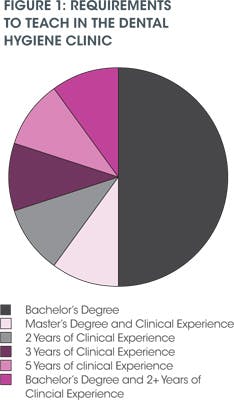The Lesson Plan
Easing into the transition from a clinical dental hygienist to a dental hygiene educator
BY JERELYN CHAMPINE, RDH, BSDH
"Education is the most powerful weapon which you can use to change the world." - Nelson Mandela
Many dental hygienists have transitioned from working in the clinical setting to teaching in the classroom as a faculty member. I, too, have this dream. While completing my bachelor's degree at Ferris State University in Michigan, I was a student teacher, which strengthened my determination to make my dream of becoming a faculty member a reality.
In my journey to explore the possibility, I had to answer some basic initial questions: Is there a need for dental hygiene educators? What are the education requirements for teaching dental hygiene? What role does accreditation play in dental hygiene programs? What makes an effective dental hygiene educator?
Is there a need for dental hygiene educators?
In October 2008, a survey was sent to faculty members at 297 entry-level dental hygiene programs, with a 65% response rate.6 Nearly 10% of the sample indicated that they planned to retire within the next five years, and one-third of those who indicated plans to retire were program directors.6 Now that those five years have come and gone, have we met the challenge to fill the void?
Since 1992, surveys of dental hygiene program directors have demonstrated concerns about a shortage of dental hygiene educators. To cope with the shortage, the number of part-time faculty has increased, the workload of current faculty has increased, and programs are hiring faculty with fewer credentials to fill the void. In order for our profession to move forward, more qualified educators need to be hired.6 In a 2008 American Dental Hygienists' Association (ADHA) study, program directors indicated three primary concerns for the present and future: the need for new faculty, the addition of new curricular material, and competition for qualified faculty and budget.3 Program directors also indicated that future faculty should have experience in teaching, research, patient care, administration, and sales/marketing.6
A peer-review of professional publications found that there were six causes of faculty shortages in dental professions, including "inadequate compensation, lack of diversity amongst faculty, inadequate mentoring for new faculty, lack of modeling to prospective dental hygiene educators, little awareness of faculty shortages, and lack of institutional support for dental hygiene faculty."4 In addition, leadership and administrative responsibilities can limit program directors from being able to teach courses, further contributing to the shortage.
What are the education requirements for teaching dental hygiene?
In January 2014, I distributed a survey to 13 dental hygiene program directors in Michigan (see sidebar). The survey asked questions about the type(s) of degrees needed for teaching, ways to prepare for a teaching interview, ways to prepare for a career in teaching, the job outlook, and the pay scale. Ten of the program directors replied.
Most of the program directors who responded indicated that a bachelor's degree and clinical experience are sufficient for teaching in the dental hygiene clinic at their respective programs (see Figure 1), although a master's degree is needed to teach a didactic course. While some of the program directors indicated that the master's degree should be in dental hygiene, not all responses were specific about the type of degree needed.
The program directors who responded recommended preparing for teaching interviews by considering and/or studying the following topics:
• How you manage conflict issues
• The accreditation process
• How you function in team settings
• What unique skill set you would bring to the school
• Philosophical questions.
You should also take continuing education (CE) course about dental hygiene practices, be a role model for students, have a passion for dental hygiene education, take courses in methodology, observe faculty members, and stay up-to-date on current research.
Staying up-to-date on research and taking courses are important because dental hygiene educators need to be competent in so many areas, including technology, communication, compassion, flexibility, etc. Furthermore, new educators may also need to be trained in new modes of content delivery. For example, distance learning is becoming more common. In 2002, 22% of dental hygiene programs used distance learning for some of their curriculum.
What role does accreditation play in dental hygiene programs?
Accreditation standards put a lot of demands on dental hygiene educators because hygiene educators have to teach many different subjects to students in order to produce prepared dental hygienists in a short amount of time. As licensed professionals who have been those students, we had (and still have) the opportunity to choose from six other career paths beyond being a clinician - including working in public health, working for corporations, conducting research, working as administrators, becoming entrepreneurs, and finally, educating. To prepare to become competent educators in the field of dental hygiene, we must first understand the accreditation process.
The American Dental Association's (ADA) Commission on Dental Accreditation has existed since 1975. According to the ADA, it is "the only nationally recognized accrediting body for dentistry and the related dental fields."2 In a nutshell, the board creates and adopts the requirements and procedures for the accreditation of dental educational and dental auxiliary educational programs. The Commission's first concern is to be accountable to the public. It ensures that dental and dental-related programs meet specific educational standards, and it evaluates the educational quality of the programs. For more information, read about the Accreditation Standards for Dental Hygiene Education Programs on the American Dental Association website at ada.org/en/coda/current-accreditation-standards.
Although the Commission on Dental Accreditation has been around since 1975, the first dental hygiene accreditation standards were created by the American Dental Hygienists' Association, the National Association of Dental Examiners, and the American Dental Association's Council on Dental Education.1 These standards were reviewed and approved by the ADA House of Delegates in 1947.1 This was five years before the first accreditation of a dental hygiene program in 1952. By 1953, there were 21 programs accredited.1
To this day, dental hygiene programs are driven by accreditation. The curriculum of the dental hygiene program must have courses in four areas: general education, biomedical sciences, dental sciences, and dental hygiene science.1 The Commission dictates the specific classes that dental hygiene students must take in each of these areas. The number of hours of clinical practice scheduled must ensure that students attain clinical competence and develop appropriate judgment, and clinical practice must be distributed throughout the curriculum.1
Entry-level dental hygiene programs train students for clinical practice. Students graduate with a certificate, associate's degree, or bachelor's degree. Dental hygienist graduates with an associate's degree will have about 86 credit hours; graduates with a bachelor's degree will have about 122 credit hours.
Bachelor's and master's degree programs offer licensed dental hygienists opportunities for careers in education, administration, public health, and research. Half of the master's degree programs indicate that their students are interested in teaching.3
There are 332 entry-level dental hygiene programs, 55 degree completion programs, and 22 master degree programs in the United States.3 Of the 242 entry-level programs, 174 programs are part of community colleges.3 Eighty-eight percent of the program directors are dental hygienists.3
What makes an effective dental hygiene educator?
Dental and dental hygiene students are frequently taught by skilled clinicians with minimal formal education in teaching.7 A qualitative study was conducted to identify effective teaching behaviors of instructors who taught dental and dental hygiene students in the classroom and in the clinic.7 Through this study, seven factors influenced students' perceptions of an effective learning experience: individual rapport between student and teacher, organization, the teacher's enthusiasm, learning, the quality of group interaction, the quality of exams and assignments, and coverage of a breadth of material.7
In the classroom setting, organization and rapport were reported as the most effective teaching behaviors.7 In the clinical setting, rapport was reported as the most effective behavior.7 If you're interested in becoming a dental hygiene educator, the results of this study should give you an idea about the skills you'll want to hone.
As you know, becoming an educator is one of the many career options that you can choose as a dental hygienist. Through my research, I discovered that there will continue to be a shortage of dental hygiene educators over the next five to 10 years. To teach in a dental hygiene clinic, you'll need a bachelor's degree and clinical experience, whereas you'll need a master's degree to teach didactic courses.
If you're interested in teaching, you should also find a mentor at a dental hygiene school, take courses in methodology, and stay current in the field. Being a role model for students and having a passion for dental hygiene education are also important assets in becoming a teacher. If you're a dental hygienist who is interested in a career as a dental hygiene educator, now is the time to pursue further education and obtain a master's degree. I hope this information will encourage others to continue with their education and pursue careers in dental hygiene education!
Author's Note: The author gratefully acknowledges the assistance of Kathy Harkan, RDH, with the preparation of this article.
JERELYN CHAMPINE, RDH, BSDH, earned her associate's degree from Delta College in 1999 and her bachelor's degree from Ferris State University in 2014. She is a member of the American Dental Hygienists' Association and the Mideast District Dental Hygiene Society. She is also the past president and former co-webmaster of the Michigan Dental Hygienists' Association. She resides in Midland, Michigan, with her husband, Russ, and their two dogs. She can be contacted at [email protected].
References
1. American Dental Association (ADA) Commission on Dental Accreditation (January 1, 2013). Accreditation Standards for Dental Hygiene Education Programs. Retrieved from website, June 7, 2014, http://www.ada.org/~/media/ADA/Education%20and%20Careers/Files/dh.ashx.
2. American Dental Association (ADA) Commission on Dental Accreditation. (August 2013). Evaluation and Operational Policies and Procedures Manual. Retrieved from website, June 7, 2014, http://www.ada.org/~/media/CODA/Files/eopp.ashx.
3. American Dental Hygienists' Association (ADHA) (October 7, 2013). Dental Hygiene Education, Curricula, Program, Enrollment and Graduate Information. Retrieved from website, November 15, 2013, https://www.adha.org/resources-docs/72611_Dental_Hygiene_Education_Fact_Sheet.pdf.
4. Baus L, Carr E, Ennis R. (2010, Fall). The dental hygiene faculty shortage: causes, solutions and recruitment tactics. Journal of Dental Hygiene, 84(4), 165+. Retrieved from http://go.galegroup.com/ps/i.do?id=GALE%7CA253387740&v=2.1&u=lom_ferrissu&it=r&p=EAIM&sw=w&asid=1a1d4ddc35087e0b4dd26d78211aee83.
5. Coplen AE. (2010, September-October). The need for new qualified dental hygiene educators. Access, 24(8), 4+. Retrieved from http://go.galegroup.com/ps/i.do?id=GALE%7CA240715991&v=2.1&u=lom_ferrissu&it=r&p=AONE&sw=w&asid=cd4a75f16bc5f0ba5805d62ed50144e9.
6. Coplen AE, Klausner CP, Taichman LS. (Winter 2011). Status of current dental hygiene faculty and perceptions of important qualifications for future faculty. Journal of Dental Hygiene, 85(1), 57+. Retrieved from http://go.galegroup.com/ps/i.do?id=GALE%7CA253386776&v=2.1&u=lom_ferrissu&it=r&p=EAIM&sw=w&asid=74fbd40d187652098ad8db61931c3a4d.
7. Schönwetter DJ, Lavigne S. Mazurat R, Nazarko O. (June 1, 2006). Students' Perceptions of Effective Classroom and Clinical Teaching in Dental and Dental Hygiene Education. Journal of Dental Education, vol. 70 no. 6 624-635. Retrieved from website, http://www.jdentaled.org/content/70/6/624.full.
Survey Questions
1. What are the requirements to teach in the dental hygiene clinic at your school
2. What are the requirements to teach in a dental hygiene class at your school
3. Would you recommend that hygienists who are interested in becoming hygiene instructors pursue master's degrees prior to teaching or wait until after they've begun teaching
4. What recommendations would you have to help a clinical hygienist prepare for working in a dental hygiene clinic or teaching a dental hygiene course
5. What is the five-year job market outlook for a hygienist interested in teaching
6. What is the pay scale for hygienists who work in dental hygiene clinics or as teachers
7. What recommendations would you have to help a clinical hygienist prepare for an interview in a dental hygiene clinic or for a teaching interview
8. How does your college inform hygienists of job openings for dental hygiene clinic instructors or teachers
9. Are there any suggestions that you would like to add
Past RDH Issues


